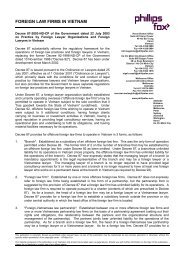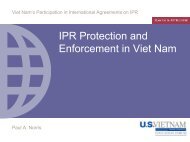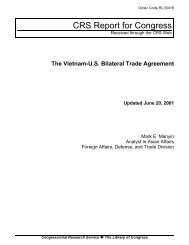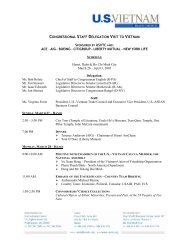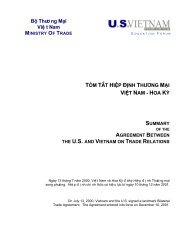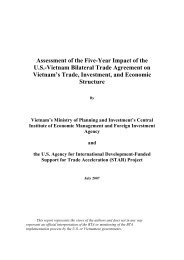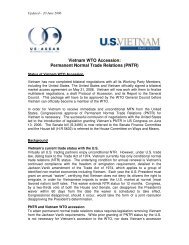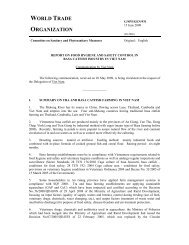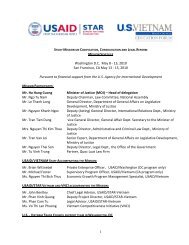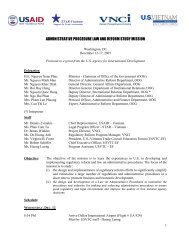Climate risks and adaptation in Asian coastal megacities: A synthesis
Climate risks and adaptation in Asian coastal megacities: A synthesis
Climate risks and adaptation in Asian coastal megacities: A synthesis
- No tags were found...
You also want an ePaper? Increase the reach of your titles
YUMPU automatically turns print PDFs into web optimized ePapers that Google loves.
Importance of BMR to the regionaleconomyThe Bangkok Metropolitan Region (BMR) is theeconomic center of Thail<strong>and</strong>. It is the headquartersfor all of Thail<strong>and</strong>’s large commercial banks <strong>and</strong>f<strong>in</strong>ancial <strong>in</strong>stitutions. The area to the east of Bangkok<strong>and</strong> Samut Prakarn is also an important <strong>in</strong>dustrialzone. In 2006, the gross domestic product (GDP) ofthe Bangkok Municipal Region was 3,352 billionbaht, or 43 percent of the country’s GDP (7,830 billionbaht). The annual average growth rate was 7.04 percent,<strong>and</strong> per capita GDP was 311,225 baht (Bangkokcase study report). The current official population ofBangkok is estimated to be about 10 million people(based on 2007 estimates) with an estimated growthrate of .64 percent between 2003–07. 30Nature of urban povertyAs stated <strong>in</strong> the Bangkok study, <strong>in</strong> 2007, 0.6 percentor 88,361 people <strong>in</strong> the BMR were poor (Table 3.1).The poverty l<strong>in</strong>e for the Bangkok municipal regionwas 1,638 baht ($49) per person per month <strong>in</strong> 2007. 31The number of poor is an official estimate <strong>and</strong> doesnot <strong>in</strong>clude unregistered people. Most of the poorlive <strong>in</strong> condensed hous<strong>in</strong>g <strong>and</strong> are unregistered.Statistics from the Office of National Economic <strong>and</strong>Social Development Board (NESDB 2007) show768,220 people liv<strong>in</strong>g <strong>in</strong> 133,317 hous<strong>in</strong>g units ofthe condensed hous<strong>in</strong>g area. Therefore <strong>in</strong> the assessmentof flood impacts on the poor, this hous<strong>in</strong>gunit <strong>and</strong> population was used as a base for the assessmentof <strong>in</strong>come loss of the poor.<strong>Climate</strong> <strong>and</strong> precipitation <strong>in</strong> the ChaoPhraya River Bas<strong>in</strong>Bangkok has a tropical monsoon climate. The averageannual ra<strong>in</strong>fall over the bas<strong>in</strong> is 1,130 mm, <strong>and</strong> ishigher <strong>in</strong> the northeastern region of the bas<strong>in</strong> (Table3.2). About 85 percent of the average annual ra<strong>in</strong>falloccurs between May <strong>and</strong> October (Panya Consultants2009). Tropical cyclones occur between September<strong>and</strong> October. In this case, ra<strong>in</strong>fall cont<strong>in</strong>uesfor a long period of time <strong>in</strong> a relatively wide area.The peak river discharge is registered <strong>in</strong> October atthe end of the ra<strong>in</strong>y season. Severe flood damagemay arise with high tide <strong>in</strong> this period (ibid.). BMA’smaximum temperature is <strong>in</strong> April <strong>and</strong> its m<strong>in</strong>imumtemperature is <strong>in</strong> December. The mean temperatureranges from 26 ° C to 31 ° C.Ma<strong>in</strong> climate-related drivers of flood<strong>in</strong>gSevere flood<strong>in</strong>g <strong>in</strong> Bangkok is associated withheavier than normal ra<strong>in</strong>fall occurr<strong>in</strong>g over several30This figure does not <strong>in</strong>clude unregistered migrants.31Poverty <strong>in</strong>cidence is measured at the household level bycompar<strong>in</strong>g per capita household <strong>in</strong>come aga<strong>in</strong>st the povertyl<strong>in</strong>e, which is the <strong>in</strong>come level that is sufficient for an<strong>in</strong>dividual to enjoy society’s m<strong>in</strong>imum st<strong>and</strong>ards of liv<strong>in</strong>g.If an <strong>in</strong>dividual’s <strong>in</strong>come falls below the poverty l<strong>in</strong>e, he orshe is classified as poor.Table 3.1 ■ Poverty L<strong>in</strong>e <strong>and</strong> the Poor <strong>in</strong> the BMR 1Poverty L<strong>in</strong>e (Baht/person/month) Proportion of the Poor (%) No. of the Poor (person)Prov<strong>in</strong>ce2006 2007 2006 2007 2006 2007BMA 2,020 2,065 0.51 1.14 28,692 64,422Samut Prakarn 1,647 1,712 — 0.78 — 9,961Samut Sakhon 1,511 1,564 0.76 0.42 4,313 2,436Nonthaburi 1,529 1,561 0.30 0.06 4,124 845Pathum Thani 1,409 1,458 0.56 0.20 5,376 1,939Nakhon Pathom 1,434 1,466 0.45 0.98 3,918 8,758BMR 1,592 1,638 0.43 0.60 46,422 88,361Source: The Office of National Economic <strong>and</strong> Social Development Board (NESDB), 2007 as cited <strong>in</strong> the Bangkok city study.1Most of the poor live <strong>in</strong> condensed hous<strong>in</strong>g <strong>and</strong> are unregistered. So the figure of 768,220 does not align with the number of poor <strong>in</strong> the table.24 | <strong>Climate</strong> Risks <strong>and</strong> Adaptation <strong>in</strong> <strong>Asian</strong> Coastal Megacities: A Synthesis Report



